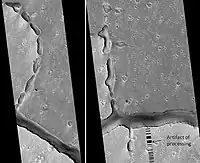 | |
| Coordinates | 21°06′N 237°30′W / 21.1°N 237.5°W |
|---|---|
| Naming | a classical albedo feature name |
The Hephaestus Fossae are a system of troughs and channels in the Amenthes quadrangle of Mars, with a location centered at 21.1 N and 237.5 W. They are 604 km long and were named after a classical albedo feature name.[1] The fossae have been tentatively identified as outflow channels, but their origin and evolution remain ambiguous.[2] It has been proposed that water may have been released into the troughs as a catastrophic flood due to subsurface ice melting following a large bolide impact.[3]
References
- ↑ "Gazetteer of Planetary Nomenclature". Astrogeology Research Program. United States Geological Survey. Retrieved 20 March 2022.
- ↑ Carr, M.H. (2006), The Surface of Mars. Cambridge Planetary Science Series, Cambridge University Press.
- ↑ "Craters and channels in Hephaestus Fossae".
See also
This article is issued from Wikipedia. The text is licensed under Creative Commons - Attribution - Sharealike. Additional terms may apply for the media files.